No products in the cart.
Fitness Tips
2023 Royal Enfield Hunter 350 Is a Nimble Urban Motorcycle
If you ride motorcycles you know lower weight is almost always a good thing. More power also can’t hurt. But most riders know that given the choice between a heavier bike with 10 more horsepower versus the same output minus 20 or 30 pounds, it’s better to take the latter and rip! So it comes as no surprise we’re really smitten with the 2023 Royal Enfield Hunter 350. It’s lighter than both the Classic 350 and Meteor 350 we’ve previously tested, but it has additional tricks we dig a lot. Here we go with a bunch of smoky burnouts, converted into English.
2023 Royal Enfield Hunter 350 Drops Weight Where It Counts
While both Classic and Meteor have their place—and truly look great—Royal Enfield wanted Hunter to bring buyers something sportier. So the maker cut weight: It’s 21 pounds lighter than Meteor and 30 pounds lighter than Classic. Royal Enfield also rearranged where the weight is carried within the cockpit, pushing it as low as possible.
A new frame, less porky headlight housing, plastic instead of metal fenders, and myriad other gram paring led to the leaner Hunter. While a 399-pound curb weight still isn’t light for the class, every bit counts when you’re only packing 20.2hp. The result is a bike that feels quicker off the line and turn to turn, even if this is hardly meant as a cross-country tourer. (None of Royal Enfield’s 350s are targeted at anyone beyond commuters and grocery getters.)
Bottom line: Having a bike that’s more readily flickable is always a good thing.
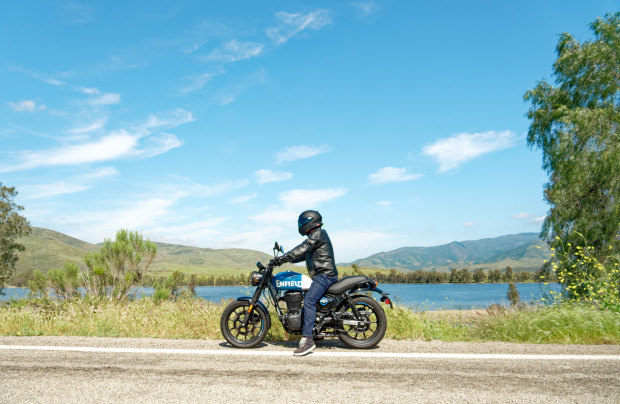
Michael Frank
Power That’s Still Approachable
Hunter 350 gets exactly the same engine as Meteor and Classic, with the Royal Enfield formula of decent 19.9 lb-ft of torque hitting in the mid-rev range at 4,000 RPM. Not having to force the little single cylinder to scream to redline makes this bike a lot more pleasurable, and that ready torque also means you’re not flogging the five-speed with constant shifts.
Third and fourth gears are happy places for backstreet swooping and in-town bopping, and although you’d likely not want to bang out long highway slogs, since the bike is pretty close to maxed out at just shy of 80mph, you’re getting a versatile-enough machine that’s friendly whether you’re poking along or want to jump ahead for a quick passing maneuver. One thing that helps there: Revised throttle mapping nudges Hunter more quickly off the line from a standstill, so it revs a bit more freely.
We also note that Royal Enfield revised the exhaust; it’s not only more compact, but emits a meatier, gutsier note. It’s totally mild at idle, and your ears will be happy for that, but winding out above 5,000 RPM gets you to the Hunter’s brawnier vocals.
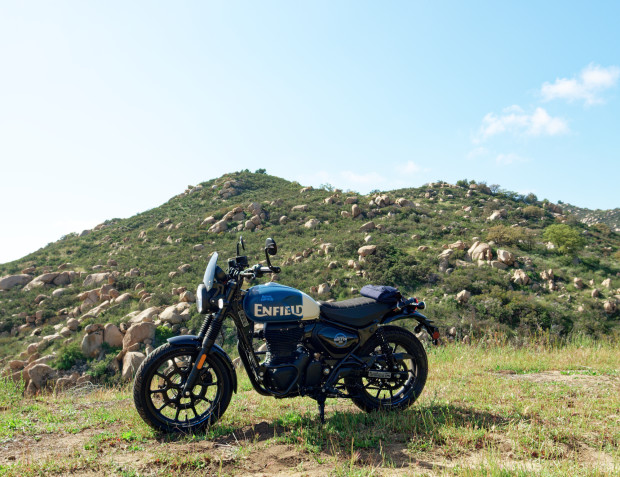
Michael Frank
A Better Setup for Performance
If Meteor and Classic are ready cruisers willing to unbend twisty blacktop, Hunter’s wider tires and revised suspension lend it quicker reflexes that we found especially handy while testing on San Diego’s crowded multi-lanes as well as carving inland canyons. That all starts with the the bike’s smaller 17-inch alloy wheels shod with 110/70 front and 140/70 rear.
We sampled both a rain-specific setup and more of a summer tire, and in the mildish weather we found reasonable grip. It’s not endless: You’ll happily lean this bike hard at speed around corners while touching down pegs here and there. You’ll find you’re on a versatile, spirited machine—but you won’t mistake it for a Ducati.
Still, because Hunter has a wheelbase that’s about an inch shorter versus Classic 350 and a steepened fork rake, this newest Royal Enfield wants to play, and you’ll easily find yourself darting around nimbly. The whole formula invites that kind of flicking around, and there’s little penalty for being frisky while learning the bike’s limits.
The best comparison might be Mazda Miata, a car that club racers love because it lets them learn but seldom bites back for making minor errors in line selection, like braking too early or late steering. Hunter is that on two wheels—it’s super playful but not super serious and constantly grin-inducing.
Speaking of the softer side of fun, Hunter’s suspended well, and somewhat more stiffly than its 350 cousins, but not harshly. The fork has 130mm travel and there’s 102mm at the rear, which is enough cush so you’re less beat up when you hit bridge expansion joints or potholes. Bigger, heavier riders can adjust the dual shocks at the rear with six preload settings to reduce any bottoming.
By the way, as a testament to the bike’s chassis, Royal Enfield employed a photo crew to snap while the media test rode, and two dudes plus video and still camera gear amounted to over 300 pounds riding two up on one Hunter and they kept pace ably, from six lanes of highway at 75mph to rolling canyons and 8 percent grades.
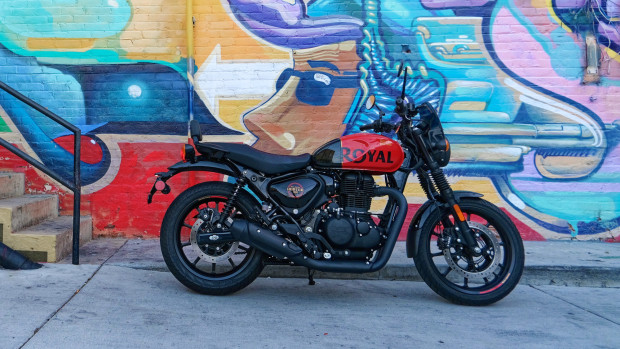
Michael Frank
Killer Looks From Scram
Royal Enfield unveiled a beautiful new paint scheme when it launched Scram last summer, a more urban-focused version of the popular Himalayan. That look, with oversized typography and bright, poppy colors carries through on Hunter. Royal Enfield also takes another cue from Himalayan by splitting the color schemes at the tank on some of the versions; the aesthetic is highly graphical rather than bound by the maker’s 122-year heritage.
Mark Wells, Royal Enfield’s chief of design, talked about how the brand breaks “rules” with lots of its looks. He stressed that, especially for new riders the Indian maker targets, pretending those buyers know or care about Royal Enfield or any other moto brands’ legacy really isn’t the point.
Partly, that includes blacking out nearly everything that’s not highlighted, from the chrome-less exhaust to the matte painted engine and fork boots that echo the horizontal grid of the motor’s cooling fins. This is a relatively small machine, and the unbroken horizontal bow of the seat rearward enhances the effect of length, adding gravitas and telling you something about the athleticism that lies within.
These details don’t whack you on the head; they’re subtly attractive instead. You notice them over time, from the emblem embedded in the center of the purposefully old-school headlight housing to the eyeliner hint of color splashed on the wheel rim edges.
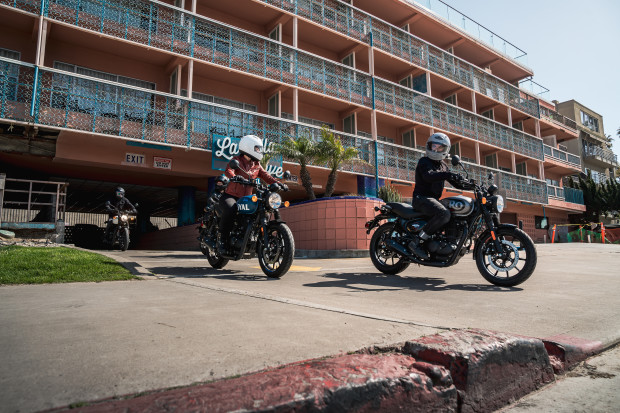
Courtesy Image
A Riding Position That’s Sporty but Not Uncomfortable
Motorcycles aren’t cars. They’re templates for tinkering. If you’re taller, the 31.1-inch seat height might feel low. The bars might feel like they need a riser. But your shorter-statured reviewer digs the position, and anyone new or newish to riding will as well, because there’s no strain to the cockpit. The seat is all-day comfortable, with proper cushioning, and even if your lanky legs needed lowering pegs or you wanted to position those more forward, the aftermarket is awash in every Royal Enfield mod you might imagine.
We tested Hunters festooned in different dealer-available packages, including bar-end mirrors, fly screens that cheat a little more wind, and multiple signal configurations. Would we go aftermarket for a brighter LED headlamp? Darned straight, but wisely Royal Enfield is happy to let purchasers use Hunter as a template to begin personalizing out of the gate.
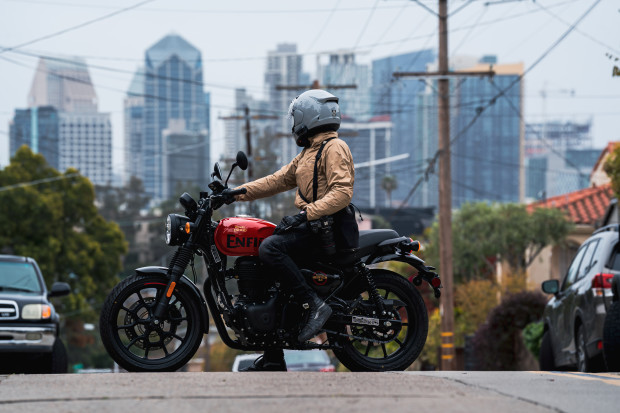
Courtesy Image
2023 Royal Enfield Hunter 350 Price
We’re honestly shocked this bike starts at a mere $3,999. A lot of used motorcycles aren’t close to that affordable—and they won’t come with a three-year, unlimited warranty with roadside assistance like Hunter. Our sole bit of advice: Get to a dealer for a test ride, ASAP!
[From $3,999; royalenfield.com]Source link

